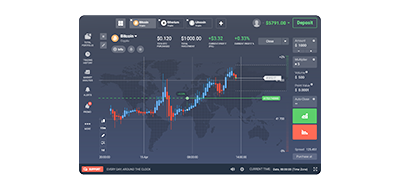Quay lại
Contents
What is Options Trading and How It Works?

Demetris Makrides
Senior Business Development Manager

Vitaly Makarenko
Chief Commercial Officer
What is Options Trading?
Options trading allows investors to speculate on the future performance of underlying assets like stocks, indexes, commodities or currencies in a defined risk manner. At its core, an option represents a contract that gives the buyer special rights regarding the purchase or sale of the underlying asset.
There are two main types of options – calls and puts. A call option gives the holder the right to buy the underlying asset by a certain date at a specific price. Buying a call works well for a bullish outlook, allowing profit if the asset price rises above the strike. Conversely, a put option grants its holder the right to sell the underlying asset at the strike price. Puts benefit bearish views and profit if the asset falls below the strike.
Key Components of Options Contracts
Underlying Asset: The security forming the basis of the option contract, such as a stock, index, commodity, or currency pair.
- Expiration Date: The last day the option can be exercised before it expires. Options have expiration cycles ranging from weeks to years.
- Strike Price: The predetermined price at which the holder can buy (call option) or sell (put option) the underlying.
- Option Type: Distinguishes an option as a call, providing the right to purchase, or a put, granting the right to sell.
- Premium: The upfront price paid by the buyer to open the options position. This is the maximum potential loss on the trade.
However, options also feature drawbacks like complexity, time decay and assignment risk requiring diligent management. Analyzing factors impacting prices like the “Greeks” necessitates ongoing study.
Overall, for experienced investors, options supply versatile tools fitting diverse goals when deployed judiciously within one’s risk tolerance. Their contractual nature facilitates customized exposures in bullish, bearish or range-bound markets. Let’s now explore options in more depth.
Options Pricing and Greeks
In addition to the variables embedded in every options contract, various interrelated market forces sway their pricing dynamically. Grasping sensitivity to these factors arms traders navigating fluctuating valuations.
Factors Affecting Prices
- Underlying asset price: Primary determinant; options gain value as underlying surpasses calls’ strikes or declines past puts’.
- Time to expiration: Near-dated options suffer steeper Theta decay. More time value aids further expiries.
- Volatility: Actual and implied vols influence premiums. Choppy markets inflate prices versus smooth sailing.
- Interest rates: Higher rates disadvantage puts from diminished borrowing costs for shorts. Calls benefit.
- Dividends: Stock distributions erode intrinsic call values if below strikes. Puts gain marginally.
The Greeks of Options Pricing
- Delta: Represents the rate of change in an option’s theoretical value with respect to a $1 change in the underlying asset’s price.
- Near-expiration options have deltas close to 0 (for out-of-the-money options) or 1 (for deep-in-the-money options) as they behave more like the underlying.
- As expiration approaches, options become either more sensitive (delta increasing) or less sensitive (delta decreasing) to changes in the underlying.
- Gamma: Measures the rate of change in an option’s delta with respect to a $1 change in the underlying asset’s price.
- Higher gamma options experience more dramatic changes in their delta.
- Options with expiration further away tend to have higher gamma since their deltas are less static.
- Vega: Measures the rate of change in an option’s theoretical value for a 1% change in implied volatility.
- Prices generally increase if volatility rises and decrease if it falls
- Options close to expiration have smaller Vega values since volatility impacts them less over their shorter lives
- Theta: Represents the rate of decrease in an option’s theoretical value for a one-day reduction in time to expiration.
- Theta accelerates as expiration nears, causing options to decay faster the shorter their lives.
- A one-day move in time makes a bigger difference for short-term options.
- Rho: Measures the rate of change in an option’s price due to a 1% change in interest rates.
- Puts tend to increase in value when rates rise and calls when rates fall, due to put call parity.
- Short-dated options have less rho exposure due to less time for rates to change.
Implied Volatility and Technical Analysis also impact pricing. Mastering these Greeks aids in navigating fluctuating derivative valuations strategically.
How Options Trading Works
Now that we understand options fundamentals, let’s delve into the practical aspects of trading them. This section will cover the mechanics of opening and closing positions, leveraging options, associated costs, expiration scenarios, analytical tools and risk management strategies.
Opening and Closing Positions
To open a position, traders enter market orders to buy to open a long call/put or sell to open a short one. Buying establishes the right to exercise while selling obligates delivery if assigned.
Positions are unwound by selling to close a long holding or buying to close a short for profits or loss mitigation. Brokers facilitate these transactions through order execution platforms.
Leverage and Margin Requirements
Options multiplicatively impact portfolio returns relative to the underlying moves. However, unlike stocks requiring full purchase value, margin accounts allow leveraging buying power.
Brokers set initial and maintenance margin levels dictating the collateral needed. Leverage boosts percentage gains yet also amplifies the downside, warranting prudent sizing.
Transaction Costs
While some stock trades are commission-free, options involve brokerage fees. Exchanges also levy regulatory charges passed to traders. Cost structures vary – per contract, tiered pricing or bundles. Researching low-cost professionals suits optimization. Taxes further impact profits according to holding periods.
Expiration and Assignment
Open positions close automatically at expiration if not executed earlier. ITM options may get assigned, exercising the right to sell or buy stock at the strike. OTM options expire worthless, limiting loss to premium. Traders prepare by hedging exposure around expiries or adjusting positions proactively.
Analytical Tools
Brokers supply real-time quotes, charting and technical indicators. Screeners filter contract attributes. Greeks disclose sensitivities for navigating volatility. Customizations serve varied strategies by leveraging multiple data sources and risk metrics holistically.
Risk Management Strategies
The key is acknowledging options complexity while scaling positions appropriately. Profit targets, stop-losses and strategy diversification aid disciplined risk mitigation amid inevitable drawdowns. Ongoing learning also minimizes mistakes.
In closing, responsible trading demands capitalizing on options’ utility within one’s financial ability and experience. Let’s now shift to specific strategies.
Options Trading Strategies
This section will provide an in-depth analysis of various directional, volatility-focused, and structured options trading strategies. Understanding multiple approaches helps traders select suitable plays based on their market views, risk tolerance, and timeframes.

1. Bullish Strategies
- Long Calls: Buying calls leverages potential upside with limited downside risk. Traders can target OTM, ATM or ITM expirations based on their bullish views. Potential profits scale exponentially as the underlying outpaces the strike price plus the premium paid.
- Covered Calls: By writing calls against held stock, traders collect premium income while capping gains. Short calls slightly above cost basis generate premium if views are neutral to mildly bullish short-term. The downside is stock delivery at the strike.
2. Bearish Strategies
- Long Puts: Puts act as leveraged short plays, rising in value as the underlying declines. Buying OTM, ATM or ITM expirations suits impending downturn expectations or hedging short stock positions.
- Short Puts: Selling cash-secured puts presumes downward breaches will be minor, pocketing premiums intact. Substantial violations necessitate unwilling long holdings at the strike. It favors neutral outlooks.
3. Neutral Strategies
- Straddles: Purchasing call and put pairs at an identical strike and date balance volatility and directional risks. Wider ranges inflating option prices beyond premiums outlay constitute profitability.
- Covered Straddles: Combining long underlying shares with a straddle writing yields premium income while limiting unlimited liability. Trading ranges encapsulating strikes realize gains.
4. Protective Strategies
- Protective Puts: Buying downside puts matches long stock holdings, capping drawdowns at the strike-less premium. OTM Puts economize insurance for tolerating some vulnerability.
- Collars: Long stock coupled with protective puts and upside calls shields acceptable trading zones from exposure. Time decay boosts likelihood versus naked short strategies.
5. Leveraged Strategies
- Long Strangles: Holding OTM puts and calls bets on amplified volatility surpassing higher entry costs. Magnitude surpassing strikes multiplying premiums realizes profits.
- Spreads: Vertical Credit Spreads limit risk compared to singles via short premium collection. Bull and bear varieties profit if securities remain within defined bands.
As the saying goes, “Options are not suitable for all investors.” While versatile, their complexity demands ongoing study. Traders should undertake rigorous evaluation aligned with their objectives before implementation. The rewards manifest through adept comprehension and application marrying theoretical understanding with practical experience.
Pros and Cons of Trading Options

Pros of Options Trading
- Upside Potential: Options provide leverage exposure to moves in the underlying asset within the defined risk framework of the premium paid.
- Downside Protection: For those with bearish views, puts create insured downside protection while allowing participation in upward moves.
- Flexibility: Investors can fine-tune bets on the direction, magnitude and timing of price changes versus the long-term commitment of stock holding.
- Income Generation: Selling covered calls or cash-secured puts generates recurring premium income in addition to capital gains.
- Hedging Capabilities: Options facilitate mitigating portfolio risks by purchasing downside protection or offsetting bullish and bearish positions.
Cons of Options Trading
- Complex Strategies: Advanced trades like spreads, straddles and butterflies require a sophisticated understanding of Greeks and timing.
- Cost of Trading: Brokerage commissions and fees are incurred with each opening or closing of options contracts.
- Time Decay Threat: Options lose value predictably as expiration nears, necessitating active management or earlier exits.
- Higher Probability of Loss: While risk is limited, increased leverage from wrong way moves results in proportional loss of initial capital outlay.
- Assignment Risk: Those selling call or put options face potential forced delivery or receipt of the underlying asset if exercised.
In summary, options trading rewards knowledge but demands ongoing study to realize its versatile applications and manage inherent risks prudently. Both costs and benefits require evaluation.
How to Trade Stock Options
1. Evaluate Your Readiness
Before trading options with real money, carefully evaluate your financial situation, investment experience, risk tolerance, and available time commitment. Assessing these factors upfront will help determine whether options are suitable for your needs and abilities. It is important to approach options trading with the right mindset given the risk involved.
2. Choose a Broker
Research top brokers known for low trading costs, robust educational resources, and useful analytical tools. Consider which broker best fits your requirements. Apply for an account and have your knowledge and financial capacity evaluated through a screening process. Establishing an account with the right broker lays the groundwork for your options trading.
3. Create a Trading Plan
Take time to formalize your intended strategies through developing entry and exit criteria for different market scenarios. Use backtesting tools to analyze hypothetical performance before putting a plan into action with real capital. Thorough planning is essential for implementing disciplined decisions.
4. Understand Taxes
It is prudent to educate yourself on the tax treatment of options profits versus stock holdings based on periods. Being aware of these implications aids long-term success through maximizing after-tax returns according to personal tax brackets.
5. Continue Learning
Managing risk demands permanent learning as changes occur in available products, best practices, and your experience. Practice risk management by starting conservatively in simulation and with small trade sizes as competence increases. Ongoing education helps navigate inevitable market fluctuations as an options trader.
Conclusion
Mastering options as a tool in your investing repertoire requires dedication to learning underlying theory and real-world practice over paper simulation. With openness to refine strategies, you build versatility responding to diverse market backdrops benefiting a balanced portfolio in the long run.
Only risk funds are expressly earmarked for high-risk vehicles to avoid emotional reactions. Stay patient, manage risk astutely through diversification and position sizing according to your defined plan. Approach options as a supplement within comprehensive financial goals and risk tolerance. Regularly reassess strategies and make adjustments fueling continual mastery
Đã cập nhật:
19 tháng 12, 2024

